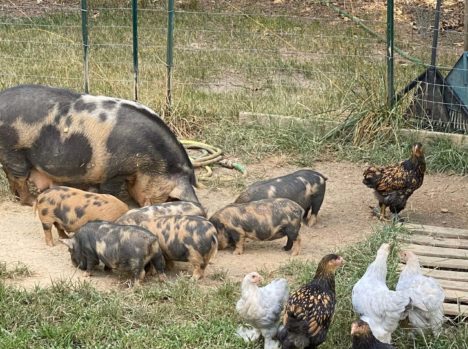
JOIN US
GET OUR KUNEKUNE
NEWSLETTER
New and highly discounted products, fresh and hot stories & useful information
What is the purpose of KuneKune wattles?
KuneKune Wattles
Learn about the purpose of KuneKune wattles, beyond breed standards and characteristics of the breed. Should you register unwattled KuneKunes? Learn more about KuneKune wattles and see frequently asked questions.
Written by Kathy Petersen of Virginia KuneKunes

What are KuneKune wattles?
KuneKune wattles are a unique and distinguishing feature of the KuneKune pig breed. These small, fleshy, and tassel-like appendages are located on the pig's jaw, just below its cheeks. While some may dismiss them as mere decorative elements, KuneKune wattles serve multiple practical and evolutionary purposes.
KuneKune Wattles Primary Function
One of the believed primary functions of KuneKune wattles is thermoregulation. (See below for more in-depth information on what thermoregulation means and how it applies to pigs). Pigs, especially those living in warmer climates, are prone to overheating due to their lack of sweat glands. In such environments, KuneKune wattles are believed to aid in the regulation of body temperature by increasing the surface area of the pig's skin, allowing for better heat dissipation. Additionally, the blood vessels within the wattles help in cooling the blood before it is circulated through the rest of the body, preventing the pigs from suffering from heat stress.
Are KuneKune Wattles Used as a Means to Social Interactions?
KuneKune wattles play a crucial role in communication and social interactions among pigs. Pigs are highly social animals, and they use various vocalizations, body language, and physical traits to communicate with each other. KuneKune wattles are believed to be important in conveying social cues and emotions, such as aggression, submission, and reproductive readiness, to other pigs. Thus, it is believed they are an integral part of the pigs' communication system and play a role in maintaining social cohesion within the herd. I have never personally noticed this but, included it as it is interesting.

The Evolutionary Perspective of KuneKune Wattles
From an evolutionary perspective, KuneKune wattles also hold significance. They are a part of the ancient genetic makeup of the KuneKune breed, which originated in New Zealand and flourished as a free-range pig, adapted to its natural environment. Wattles are believed to have been developed over time through natural selection to serve as an adaptive trait, offering survival advantages in their particular natural environments.
More on the topic
Despite their functional and evolutionary significance, KuneKune wattles are often overlooked or misunderstood. Some may see them as an inconvenience or solely as a cosmetic feature, rather than recognizing their practical and evolutionary importance. However, these unique appendages contribute to the overall well-being and social dynamics of KuneKune pigs. Not to mention having wattles is not only a breed characteristic but also a part of the breed standard.
KuneKune wattles are not just decorative appendages but could serve multiple vital functions in the lives of these pigs. They could play a crucial role in thermoregulation, and communication, and may have evolved as an adaptive trait. Understanding and appreciating the importance of KuneKune wattles can lead to better care and management of these unique and valuable animals.
The Genetics Behind KuneKune Wattles
KuneKune pigs are known for their friendly nature, small size, and distinctive physical features, including their wattles. Wattles are fleshy growths hanging from the lower jaw of the pig, and they are a defining characteristic of the KuneKune breed. These wattles have stimulated the interest of geneticists and breeders alike, as they seek to understand the genetic basis for this fascinating trait.
Is it a Crap Shoot?
We have often heard there is no rhyme or reason to the inheritance of wattles, and it is a crap shoot. I have personally bred a female with no wattles to a boar with double wattles and in the 10 piglets born, all were double wattled. I have also bred two double-wattled parents and received half a litter with no wattles. When selecting your breeding pairs, you just do not know how those genes will mix when the egg is fertilized. Thus, some say it is a crap shoot.
The presence of wattles in KuneKune pigs is a dominant genetic trait, meaning that if a pig inherits the gene for wattles from either parent, it will have them. This is in contrast to recessive traits, where a pig must inherit the gene from both parents to display the trait. Therefore, KuneKune pigs can have wattles even if only one parent has them.

Further Testing Available?
Pig-specific genetic processes behind the development of wattles in KuneKune pigs are not yet fully understood, but research in this area is ongoing. A combination of genes is responsible for the formation of the wattles, and determining which genes are involved is a complex and ongoing process. Currently, there is no DNA to help answer the question behind the inheritance of wattles.
Understanding the genetics of KuneKune wattles not only provides insight into the unique traits of this breed but also has practical implications for breeders. By understanding the inheritance patterns of wattles, breeders can make informed decisions about which pigs to breed to produce offspring with the desired wattle traits. However, the best plans sometimes take a turn.
Summary
In conclusion, the genetics behind KuneKune wattles is an area of ongoing research and interest. Understanding the genetic basis for this unique trait not only enhances our knowledge of the KuneKune breed but also has broader implications for our understanding of genetic traits in other livestock species. As research in this area continues, we can expect to gain a deeper understanding of the genetic mechanisms underlying the development of wattles in KuneKune pigs, and this knowledge may have practical applications for breeders and broader implications for our understanding of genetics and evolution.
What is Thermoregulation in Pigs?
Thermoregulation is an essential biological process in all animals, including pigs. It refers to the ability of an organism to maintain its body temperature within a certain range, despite changes in the external environment. In the case of pigs, thermoregulation is particularly crucial because they are sensitive to temperature fluctuations and can easily suffer from heat stress or cold stress if their body temperature is not properly regulated. Let us discuss the mechanisms and importance of thermoregulation in pigs.
Pigs are heat-absorbing animals, meaning they generate their body heat internally. The thermoregulatory system in pigs involves a complex interplay of physical and behavioral mechanisms that work together to maintain their body temperature. One of the key physical mechanisms involved in thermoregulation is the regulation of blood flow. When pigs are exposed to cold temperatures, blood vessels in their skin constrict to reduce heat loss to the environment. On the other hand, when pigs are exposed to heat, the blood vessels dilate to increase heat loss through the skin. Additionally, pigs have a thick layer of subcutaneous fat that acts as insulation, helping to retain body heat in cold environments.
In addition to these physical methods, pigs also exhibit a range of behavioral adjustments to regulate their body temperature. For example, pigs may seek out shelter or mud to cool down in hot weather, or they may huddle together to conserve body heat in wintry weather. They may also adjust their activity levels and metabolism to regulate their body temperature more efficiently.
The importance of thermoregulation in pigs cannot be understated. Pigs are particularly sensitive to heat stress, which can lead to reduced feed intake, decreased growth rates, and even death in severe cases. On the other hand, cold stress can also have damaging effects on pigs, leading to increased energy requirements and higher sensitivity to diseases. Therefore, maintaining an optimal body temperature is essential for the health and well-being of pigs, as well as for their productivity and profitability in the agricultural industry.
In Summary
In conclusion, thermoregulation is a vital process in pigs that involves a combination of physical and behavioral mechanisms to maintain their body temperature within a certain range. Given the sensitivity of pigs to temperature fluctuations, proper management of their environment and welfare is crucial to ensure their health and productivity. As our understanding of thermoregulation in pigs continues to improve, farmers and animal scientists need to implement effective strategies to moderate the effects of heat and cold stress on pigs and ensure their well-being.
Frequently asked questions
Should you register unwattled boars?
For me in my breeding program, I had two boars without wattles move into another breeder’s program. They had extremely excellent conformation and it was also in the earlier preliminary stages of the breed. Later in our breeding program, we decided there was no advantage to the breed to sell any male piglets without wattles. Instead, neutered, we kept them as companions to boars and grew them up for pork or sold them to others to grow out their pork or to serve as companions to gilts or boars.
Should you register unwattled females?
In our breeding program, we did not discount a female with strong conformation as not a breeding pig. Since they still carry the gene for wattles, they could continue their breeding life producing wattles even though they did not possess them. The choice is yours in IKKPS as to what you deem worthy of carrying your name as a breeding animal.
What does the breed standard say about wattles?
The breed standard of most of the KuneKune registries will show 2 wattles as the standard. Most KuneKune registries leave it up to the breeder to decide what they deem worthy of registering. With that said, IKKPS believes in the breeder’s choice. It is your choice whether you think an animal is worthy of breeding and carrying your name as the breeder. IKKPS accepts double-wattled and unwattled pigs to be registered as breeding stock.
Registry Office
17500 Hamilton Arms Court Dewitt, VA 23840